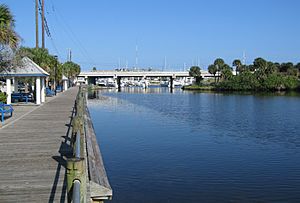Crane Creek (Melbourne, Florida) facts for kids
Quick facts for kids Crane Creek |
|
|---|---|

Crane Creek & Crane Creek Promenade
|
|
| Country | United States |
| Physical characteristics | |
| Main source | Melbourne, Florida |
| River mouth | Indian River |
Crane Creek is a stream in Melbourne, Florida, United States. It is about 3.3 miles (5.3 km) long. This creek flows into the Indian River, near Front Street.
Contents
Discovering Crane Creek
Crane Creek has a long and interesting history. It played a big part in how the area around Melbourne developed.
Ancient Discoveries
In the 1920s, scientists found proof that very old people, called Paleo-Indians, lived near Melbourne a long, long time ago. This was during the late Pleistocene period, also known as the Ice Age.
A scientist named C. P. Singleton found Mammoth bones on his land along Crane Creek. Another scientist, Frederick B. Loomis, came to dig up the bones. He found a second elephant skeleton with a "large rough flint instrument" near its ribs. This suggests early humans might have hunted these huge animals.
In the same layers of earth, Loomis found bones from many other animals that are now extinct in Florida. These included mastodons (like mammoths), horses, ground sloths, tapirs, peccarys (like wild pigs), camels, and even saber-tooth cats! All these animals disappeared from Florida about 10,000 years ago.
More discoveries were made at the Melbourne golf course in 1925. Scientists found human bones along with a horse tooth. They also found tools like a spear point and a scraper near bones of bears, camels, mastodons, horses, and tapirs. These finds show that early humans and these ancient animals lived in the same area.
First Settlers and the Town's Name
Crane Creek was very important for the first people who settled here. Before Melbourne became a town, hunters used the creek to travel inland.
In 1867, two brothers, Balaam Allen and Peter Wright, became the first pioneers in Melbourne. They were formerly enslaved people who became free. They settled near Crane Creek, which is now the Historic Downtown area.
The settlement was first called "Crane Creek." But after the American Civil War, its name was changed to Melbourne.
Getting Around: Travel in the Past
For many years, traveling to and within Brevard County was very difficult and slow. This changed in 1893 when Henry Flagler built a railway through the county. The train made transportation much faster and easier than anything before it. It remained the best way to travel until cars and paved roads arrived in the 1920s.

